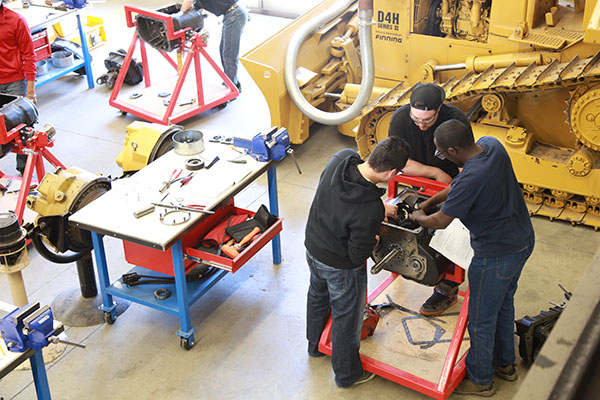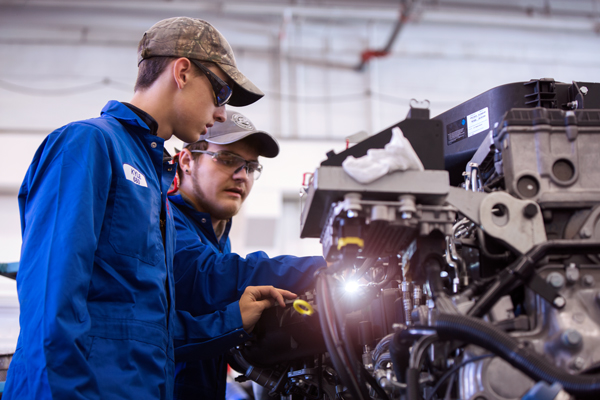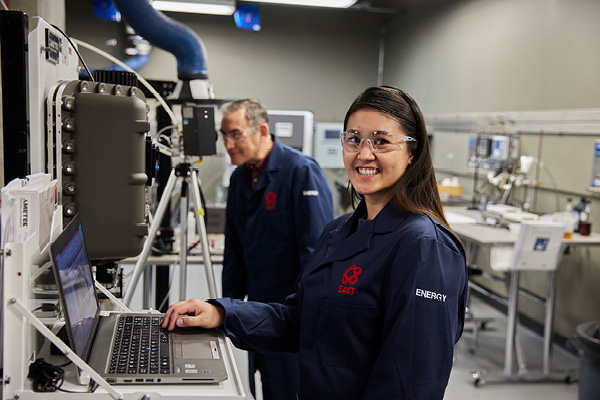On this page:
Overview
The 15-week Pre-Employment Heavy Equipment Technician program is designed for those seeking to enter the thriving transport and heavy equipment industry, repairing, maintaining and overhauling transport vehicles and heavy machinery.
With courses developed in collaboration with industry, your training will be relevant and up-to-date.
In this program, you will:
- learn safety practices and proper use of industry-standard tools
- gain entry-level proficiency in hydraulics, pneumatic braking systems, electrical circuits, mechanical skills, and suspension systems
- get hands-on experience in a shop environment supported by theory.
As a graduate, you will be prepared for entry-level roles such as heavy-duty mechanic (off-road), truck and transport mechanic and transport-trailer technician.
Your skills will apply to numerous vehicles and equipment, including, but not limited to, transport trucks and trailers, construction heavy equipment, stationary equipment and off-road vehicles. You'll also have the foundational skills to seek employment and register as an apprentice.
Apply today and propel yourself into an industry that is the backbone of construction and transportation.
Those working as heavy equipment technicians need:
- good vision, hearing and sense of smell to diagnose problems
- strength and stamina for working with heavy equipment and in cramped or awkward positions
- mechanical ability
- the ability to work alone or as part of a team
- the ability to think logically
- an interest in all types of machinery and engines, electronics and precision equipment.
You should enjoy doing precision work, solving problems, and working with your hands.
This program aligns with the first period of Alberta Apprenticeship and Industry Training's (AIT) Heavy Equipment Technician curriculum.
Graduates are eligible to register as apprentices and challenge the first-period exam.
Once you pass the exam and complete the necessary training hours with an employer, you may register for SAIT's Heavy Equipment Technician apprenticeship program beginning in period two.
Graduates may also receive course credit towards classes in our two-year Transport and Heavy Equipment Technology diploma program.
After successfully completing this program, you'll receive a SAIT Pre-employment Heavy Equipment Technician certificate.
Careers and opportunities
Our graduates may work in the following occupations. Some careers require additional experience and education.

Career planning support
Unsure which career path is for you? Here are some recommended career planning resources to help you decide your future.
You can also head to Alberta alis for lots of information about careers in Alberta, including quizzes and labour market information to help you narrow down a path.
Finally, you can take our online career finder quiz, which can help narrow your options based on your current skills and interests.
Courses
The Pre-employment Heavy Equipment Technology certificate requires 15 credits (five courses) to complete.
| Course | Credits |
|---|---|
|
This course introduces you to the fundamentals of the hydraulic systems found in heavy machinery. You will learn how to assemble basic hydraulic circuits based on hydraulic principles, and you'll examine hydraulic system components and their operations. You will also get hands-on experience rebuilding hydraulic system components and applying the theory you have learned in a lab setting. |
3 |
|
This course explores the principles of brake system operation. You will examine the operating principles and service procedures of hydraulic brake system components, power braking systems and parking brake systems, as well as the operation of air brake mechanical and system components. You'll also get hands-on practice inspecting and repairing hydraulic, pneumatic and electronically-controlled and operated brake systems. |
3 |
|
This course introduces you to key topics in the theory and operation of electrical and electronic systems. You will examine how to calculate circuit values, explore the principles and theory of magnetism, and use electrical test equipment to measure electrical values and check circuit operation. You'll also service, test and charge batteries, and repair wiring harnesses, lighting circuits and circuit protection devices. The course concludes with an examination of the use and operation of electronic components and electronic control systems. |
3 |
|
This course covers the key areas you need to know to work safely and effectively. You will examine the legislation, regulations and practices that help to ensure a safe workplace, as well as the use of personal protective equipment (PPE) and safe practices for climbing, lifting, rigging and hoisting. You'll also explore safety practices for hazardous materials and fire protection in this trade. This course also includes the correct use of common hand, shop and power tools, and you'll perform basic trade calculations and accurate measurements. The course concludes with an examination of oxyfuel heating and cutting, and SMAW welding operations. |
3 |
|
In this course, you will examine the operating principles, design features and repair procedures of common frame and suspension systems, and you will service common bearings, seals, wheels, tires and hubs. You'll also explore common trailer configurations and components, and you will service trailer coupling systems and landing gear. The course also covers trailer inspections and the benefits of maintenance systems used with off-road and on-road equipment. |
3 |
Progression
You must attain a PGPA and/or a CGPA of 2.0 or better each semester and pass the prerequisite courses to progress through the program.
To qualify for graduation, you must pass all courses, attain a CGPA of 2.0 or better and complete course requirements within the prescribed timelines.
Admission requirements
Applicants educated in Canada
Applicants must demonstrate English language proficiency and completion of the following courses or equivalents:
- at least 50% in Math 20-1 or Math 20-2, or 60% in Math 20-3, and
- at least 50% in English Language Arts 30-1 or English Language Arts 30-2, and
- at least 50% in one Grade 11 Science.
SAIT accepts high school course equivalents for admission for applicants educated outside of Alberta.
All applicants who were educated outside of Canada must demonstrate English language proficiency and provide proof they meet the program admission requirements outlined above with an international document assessment. Find accepted educational documents and assessment options.
SAIT may also accept courses completed at certain international post-secondary institutions.

Academic Upgrading
Missing an admission requirement for this program? Upgrade your prior education to help you receive admission into one of SAIT's career programs.

English language proficiency
All applicants must demonstrate English language proficiency prior to admission, including students educated in Canada.
Transfer agreements
At SAIT, we have created transfer agreements with partner institutions to allow you to earn course credits toward your SAIT program based on your previously completed credentials.
Transfer Alberta search tool
Use the Transfer Alberta search tool to see all transfer agreements between Alberta post-secondary institutions (including those with the University of Calgary, Mount Royal University and Bow Valley College.)
Search transfer agreements in Alberta
There are no formal transfer agreements currently in place for this program.
Transfer options for graduates
When you have completed this program, you may continue your education at a partner post-secondary institution. These transfer agreements include partnerships within and/or outside of Canada.
Available intakes
Summer 2025
Start dates:
- Domestic students: Waitlisted
-
-
Application deadline: April 30, 2025
-
Costs
2025/26 tuition and fees
The following estimated costs are effective as of July 1, 2025.
The estimated total cost of tuition and fees is based on completing the program in one semester of study. Following a modified schedule will impact the fees you pay per semester and may alter final costs.
Domestic students
Books and supplies are approximately $1,000 - $1,500 per full-time year.
This is a bring-your-own-device program with a standard computer hardware and software requirement. See the specific requirements on our computers and laptops page.
Find your booklist on the SAIT Bookstore's website. The booklist will be available closer to the program start date. Can't find your program or course? The bookstore didn't receive a textbook list. Contact your program directly to determine if they're still refining course details or if you're in luck; no textbook purchase is required this term.

Financial aid
Paying for your education may feel overwhelming, but we have resources and programs that can help, including information about payment options, student loans, grants and scholarships.
Application process
Ready to apply?
Follow our step-by-step guide to submitting a successful application.
Communication during admission
Email is the primary source of communication during the selection process. Ensure your personal email account is managed appropriately to receive our emails, files and communications. We recommend you add the transportation.info@sait.ca domain to your safe senders list or you risk missing critical email messages.

Begin your application
Apply now using the online application portal.
Ensure you have a valid Visa or Mastercard to pay the non-refundable application fee of $120 for domestic applicants.
Information sessions
Prepare for a strong start in your chosen program or get the details you need to decide your future path.
Our expert staff and faculty are ready to answer your questions and provide information about the following:
- What sets SAIT apart
- An introduction to the program and area of study
- Admission requirements
- Future career paths
- Information on the earning potential and graduate employment rates.
Contact us
School of Transportation Advising
-
Phone - 403.284.8471
Subscribe for updates
Your journey starts here! Sign up to get important updates on:
- Transportation and logistics programs
- Application information
- Relevant news and events

Oki, Âba wathtech, Danit'ada, Tawnshi, Hello.
SAIT is located on the traditional territories of the Niitsitapi (Blackfoot) and the people of Treaty 7 which includes the Siksika, the Piikani, the Kainai, the Tsuut’ina and the Îyârhe Nakoda of Bearspaw, Chiniki and Goodstoney.
We are situated in an area the Blackfoot tribes traditionally called Moh’kinsstis, where the Bow River meets the Elbow River. We now call it the city of Calgary, which is also home to the Métis Nation of Alberta.




